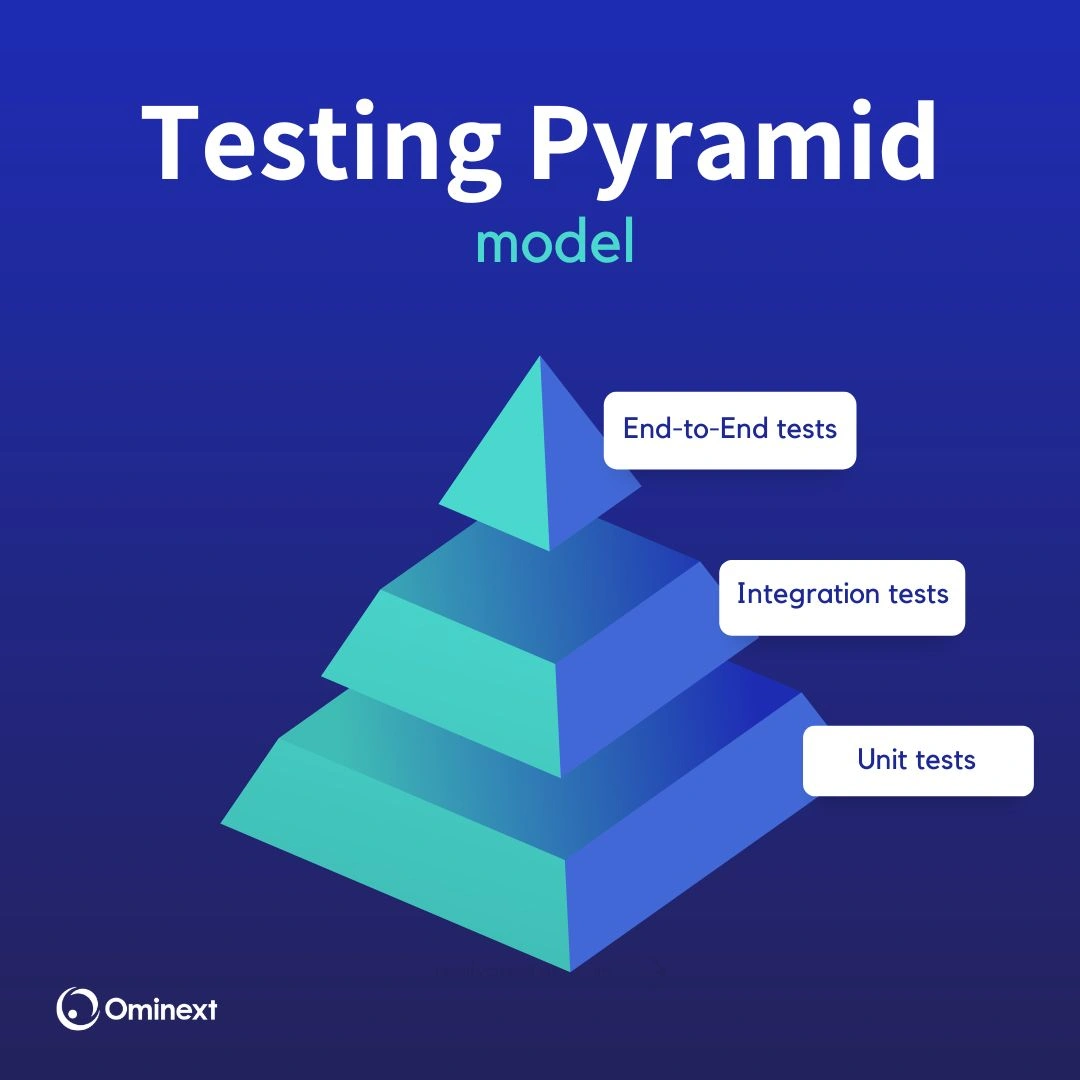The Importance of the Testing Pyramid
In software development, testing plays a crucial role in ensuring that applications run smoothly and meet user expectations. However, with the growing complexity of modern systems, testing can become a daunting task, often leading to slow development cycles, bloated test suites, and unreliable results.
This is where the concept of the Testing Pyramid comes into play. The Testing Pyramid is a strategy that helps developers structure their testing efforts efficiently by prioritizing different types of tests at various levels of the system. In this blog, we'll explore why adhering to the Testing Pyramid is essential for maintaining high-quality code while streamlining development efforts and helping teams deliver robust software on time.
What is a Software Testing Pyramid?
The Software Testing Pyramid is a conceptual framework that illustrates the different types of tests needed in a software project, organized into a hierarchy. The pyramid helps ensure a balanced approach to testing by focusing on having more lower-level, fast, and inexpensive tests at the bottom and fewer high-level, complex, and slower tests at the top. It guides teams on how to allocate their testing efforts for optimal coverage, efficiency, and maintenance.

There Are Three Layers Of The Testing Pyramid
- Unit Tests
- Integration Tests
- End-to-End Tests
1. Unit Tests (Bottom of the Pyramid)
Definition: These are the most basic and granular tests. They focus on testing individual units or components of the software, usually at the function or method level.
Purpose: Unit tests catch bugs early in development and ensure that each small part of the code behaves as expected.
Characteristics:
- Fast to execute
- Easy to write and maintain
- Provide quick feedback to developers
Example: Testing if a function that calculates the sum of two numbers returns the correct result.
2. Integration Tests (Middle Layer)
Definition: Integration tests focus on checking if different modules or components of the system work together as intended.
Purpose: Ensure that various parts of the system communicate and interact correctly.
Characteristics:
- Slower than unit tests but faster than end-to-end tests
- Moderate in complexity and maintenance
Example: Testing if a user interface correctly updates when interacting with a database through an API.
3. End-to-End (E2E) Tests (Top of the Pyramid)
Definition: These tests simulate real user scenarios by testing the entire system from start to finish, covering everything from the user interface to the backend services and databases.
Purpose: Validate that the entire application behaves as expected in real-world conditions.
Characteristics:
- Slowest to run
- Most complex and expensive to maintain
- Prone to flakiness (i.e., failing due to reasons unrelated to actual bugs)
Example: Testing if a user can log into the application, view their profile, and log out successfully.
II. Benefits of Following the Testing Pyramid
1. Efficiency and Speed
One of the key advantages of following the Testing Pyramid is the efficiency it brings to the development process. Unit tests, which form the base of the pyramid, are fast to execute because they focus on testing small, isolated pieces of code. Since they don’t rely on complex system interactions or external dependencies, unit tests provide immediate feedback on code quality.
This speed allows developers to catch bugs early in the development cycle, preventing small issues from becoming more costly problems later. By prioritizing a large number of unit tests, teams can run tests frequently without slowing down development, which keeps the workflow smooth and uninterrupted.
2. Cost-Effectiveness
By maintaining the pyramid structure, with a strong foundation of unit tests, teams can achieve comprehensive coverage while keeping testing costs low.
Unit tests are not only faster to run but also much cheaper to write and maintain compared to higher-level tests like end-to-end (E2E) tests. Since unit tests target individual functions or modules, they are straightforward to design, requiring fewer resources and less effort.
Additionally, they are less prone to breaking due to unrelated changes in the codebase, reducing the maintenance overhead. In contrast, E2E tests often require more time to set up, cover broader system interactions, and are more complex, making them costlier both in terms of time and effort.
3. Scalability
The Testing Pyramid ensures that a project can scale without becoming bogged down by slow and fragile tests. With a strong focus on unit and integration tests at the base and middle of the pyramid, developers can add more tests without significantly increasing test suite execution time. This makes it possible to scale both the codebase and the test suite efficiently. Additionally, fewer, targeted end-to-end tests mean less time spent waiting for tests to complete, even as the system grows in functionality.
4. Reduced Risk
By following the Testing Pyramid, teams build a solid foundation of unit and integration tests that can significantly reduce the risk of critical issues reaching end users. Unit tests catch the majority of bugs at the earliest stage, while integration tests ensure that the interactions between different modules are functioning correctly.
This layered approach creates multiple safety nets, catching different kinds of errors before they reach the higher-level end-to-end testing phase. With this robust testing foundation in place, critical bugs are less likely to slip through to production, reducing the risk of system failures, user dissatisfaction, or costly post-release fixes.
II. Common Pitfalls of Not Following the Pyramid
The testing pyramid is a visual representation of the ideal distribution of tests within a software development lifecycle. Adherence to this structure is crucial for efficient and effective testing as deviations from the pyramid can lead to several common pitfalls:
1. Too Many End-to-End Tests

End-to-end tests validate the entire system from a user's perspective. While they are essential for ensuring the overall functionality, relying heavily on them can lead to several issues:
- Slower test suites: End-to-end tests are typically slower to execute due to their comprehensive nature, which can significantly impact development cycles.
- Harder to maintain: As the system evolves, end-to-end tests can become increasingly complex and difficult to maintain, especially if they are tightly coupled to the implementation details.
- Higher flakiness: Due to their reliance on external factors like network conditions and databases, end-to-end tests can be more prone to flakiness, leading to unreliable results and wasted debugging efforts.
2. Lack of Unit Tests
Unit tests focus on testing individual components or units of code in isolation. They are essential for the early detection of bugs and for ensuring code quality. A lack of unit tests can result in:
- Missing early detection of bugs: Without unit tests, bugs can go undetected until later stages of development or even after deployment, leading to more costly fixes and potential customer impact.
- Leading to more costly fixes: Fixing bugs discovered later in the development process is often more expensive than catching them early on. Unit tests can help prevent these costly fixes by identifying issues at the component level.
3. Imbalanced Test Structure
An imbalanced test structure occurs when the distribution of tests deviates significantly from the ideal pyramid shape. This can lead to several inefficiencies:
- Inefficient testing: If there are too many tests at one level and too few at another, it can result in inefficient testing practices. For example, having too many end-to-end tests can slow down the testing process, while having too few unit tests can lead to missed bugs.
- Increased risk of defects: A skewed test structure can increase the risk of defects slipping through to production. A well-balanced pyramid ensures that all levels of the system are adequately tested, reducing the likelihood of issues.
III. How to Apply the Testing Pyramid in Real Projects
1. Start with Unit Testing: Build a Strong Foundation
Unit testing forms the base of the Testing Pyramid. These tests focus on individual functions or components, ensuring that each piece of code works as expected in isolation. Writing comprehensive unit tests at this stage allows you to detect bugs early and make refactoring safer.
In real projects:
- Aim for high coverage: Cover all core functionalities of your code, including edge cases.
- Use mocking: Isolate the component or function you're testing by mocking external dependencies like APIs or databases.
- Run frequently: Unit tests should be fast and run during every code change or build.
2. Use Integration Tests Sparingly: Focus on Critical Module Interactions
Integration tests verify that different modules or services work together correctly. While important, they tend to be slower and more complex than unit tests. Focus on testing the key integrations that are critical to your system’s functionality.
In practice:
- Test essential interactions: Prioritize testing how core modules interact with each other, such as database connections or API communications.
- Avoid over-testing: Only write integration tests where necessary, as testing all combinations can be costly and hard to maintain.
- Keep them focused: Test specific interactions between modules, rather than broad workflows.
3. Reserve End-to-End Tests for Key Flows: Simulate User Behavior
End-to-end (E2E) tests simulate user behavior and verify that the system works as a whole. These tests cover scenarios from the user's perspective, from interacting with the UI to the backend. However, they are slow and resource-intensive, so it's best to use them for critical workflows.
For real-world projects:
- Focus on high-value paths: Only write E2E tests for key user journeys, like logging in, purchasing a product, or submitting a form.
- Minimize reliance on UI changes: E2E tests can break easily due to UI changes, so dependency on specific UI elements can be reduced by focusing on critical behavior.
- Run periodically: Schedule E2E tests to run in CI/CD pipelines but not on every code change to prevent bottlenecks.
4. Automate Where Possible: Leverage Automation Tools
Automating your tests is essential for keeping them fast, reliable, and scalable. Automation tools ensure that tests are consistently run, results are tracked, and issues are caught early in the development process.
For real-world efficiency:
- Use CI/CD pipelines: Automate test execution in your continuous integration and deployment process to catch issues early.
- Parallel testing: Use tools that allow running multiple tests in parallel to save time.
- Monitor test health: Continuously monitor test results to ensure they remain reliable, and maintain tests to reduce false positives or flakiness.
IV. Challenges in Implementing the Testing Pyramid
While the Testing Pyramid offers a clear framework for maintaining a balanced, efficient test suite, real-world implementation can be challenging. Teams often face hurdles that make it difficult to adhere to this structure consistently. Below are some common challenges encountered when trying to implement the Testing Pyramid in practice:
1. Time Constraints: Balancing Deadlines with Writing Tests
One of the biggest challenges in software development is balancing the need for comprehensive testing with the pressure to meet tight deadlines. Implementing the Testing Pyramid requires teams to invest time in creating and maintaining unit, integration, and end-to-end tests. However, developers may feel compelled to cut corners on testing to deliver features faster.

- Tight schedules: Developers might prioritize feature delivery over test coverage due to client demands or approaching release dates, resulting in insufficient unit tests and an over-reliance on quick, high-level tests.
- Perception of low ROI: Stakeholders may not always see the immediate value of spending time on comprehensive tests, particularly unit tests that seem less critical compared to high-level end-to-end tests that simulate real user behavior.
- Skipping tests for “quick fixes”: Minor bug fixes or updates might skip tests entirely, creating gaps in coverage that could lead to bigger issues down the line.
Solution: To overcome time constraints, teams should integrate testing into the development process from the start. Using test-driven development (TDD) or allocating dedicated time for writing tests in sprints can help balance both delivery speed and quality. Automating tests and integrating them into CI/CD pipelines also ensures continuous testing without manual intervention.
2. Test Maintenance: Keeping Tests Up-to-Date as Code Changes
As code evolves, test suites must evolve with it. Maintaining tests can become a burden, particularly when dealing with integration or end-to-end tests, where even small code changes can lead to broken tests. Failing to maintain tests not only creates “test debt” but can also erode the confidence in the test suite's reliability.
- Outdated tests: When the underlying application changes but tests aren’t updated accordingly, they may no longer accurately reflect the intended behavior of the system, leading to false positives or negatives.
- Test fragility: Changes in one part of the codebase can cause cascading failures in tests, especially integration or end-to-end tests that depend on multiple modules or components.
- Ignoring failed tests: Over time, developers may grow accustomed to seeing test failures and ignore them if they think those tests are no longer reliable, which diminishes the effectiveness of the entire test suite.
Solution: Prioritize test refactoring as part of regular code maintenance, especially when refactoring or making significant changes to the codebase. Using techniques like mocking and stubbing for integration tests can reduce their fragility, and keeping unit tests isolated and focused on small components helps ensure tests stay relevant as code evolves.
3. Flaky Tests: Managing Flaky Tests, Especially in End-to-End Scenarios
Flaky tests are tests that sometimes pass and sometimes fail without any changes to the underlying code. This problem is most common in end-to-end (E2E) tests, which simulate real-world user interactions across the entire system. These tests are prone to variability because they often depend on multiple components, external services, or specific environments.
- Environment dependency: E2E tests often rely on databases, third-party services, or specific configurations, leading to intermittent failures when environments are not stable or identical.
- Timing issues: In E2E tests, interactions such as loading a page, submitting a form, or querying a database can result in inconsistent behavior if timing varies between test executions.
- Complex setup: Setting up a reliable and consistent environment for E2E tests can be difficult, leading to tests that fail for reasons unrelated to the actual code or application logic.
Solution: To manage flaky tests, focus on reducing dependency on external services or complex environments by using mocks or stubs where possible. Additionally, ensure that tests are isolated and run in controlled environments to minimize variability. Regularly review and address flaky tests to prevent them from undermining the team's confidence in the test suite. Tools that help detect and track flaky tests can assist in identifying patterns and determining root causes.
Conclusion
The Testing Pyramid is a critical framework for building efficient, reliable, and maintainable software testing strategies. By prioritizing unit tests at the base, integration tests in the middle, and reserving end-to-end tests for key workflows, teams can optimize test coverage while keeping execution time and maintenance efforts manageable. Following this structure not only improves bug detection early in development but also enhances overall code quality, development speed, and team confidence in the product.





